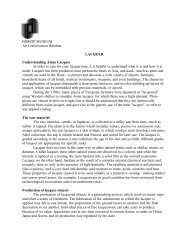INTRODUCED MARINE SPECIES IN PAGO ... - Bishop Museum
INTRODUCED MARINE SPECIES IN PAGO ... - Bishop Museum
INTRODUCED MARINE SPECIES IN PAGO ... - Bishop Museum
Create successful ePaper yourself
Turn your PDF publications into a flip-book with our unique Google optimized e-Paper software.
the total biota in these two embayments. Although they do support corals and coral reefs, both<br />
Kane‘ohe Bay and Waikiki are highly disturbed environments with histories of marine species<br />
introductions and plentiful artificial surfaces, and Kane‘ohe Bay especially has many harbor<br />
characteristics such as low flushing rates, relatively high organic, nutrient, and turbidity content,<br />
and non-reef biotopes that may support a variety of introduced organisms. More typical coral reef<br />
environments supporting coral dominated biota occurred at Kaho‘olawe, Midway, French Frigate<br />
Shoals and Johnston Atoll, where NIS were only a minor (0.3-1.5%) component of the total biota.<br />
All of these reef areas are remote from large harbors and therefore presumably relatively isolated<br />
from major sources of marine introductions. Proximity to harbors or docking areas has been<br />
indicated to be a major contributing factor in the occurrence of NIS on coral reefs determined on<br />
rapid assessment surveys underway in the main Hawaiian Islands (Coles et al. in prep). The<br />
overall values of 3-4% NIS shown in Table 7 for surveys completed on Kaua‘i, Moloka‘i and Maui<br />
are averages of values which ranged from as high as 8-9% on small reefs in the vicinity of<br />
Nawiliwili and Port Allen harbors on Kaua‘i to zero on remote reefs on Moloka‘i and Maui, with<br />
most reefs that are distant from harbors showing NIS percentages of 1-3%, similar to the values<br />
found for American Samoa reefs (Table 5) or around the island of Guam (Table 7).<br />
VI. MANAGEMENT CONSIDERATIONS<br />
The results of this survey indicate that introduced marine species are a minor component of the<br />
total biota of Pago Pago Harbor and an even less frequent and smaller percentage of the total<br />
biota in coral reef areas both in and outside of the harbor. Nonindigenous and cryptogenic<br />
species are mostly confined to the docking areas of the innermost harbor, where they are fewer in<br />
number and a smaller component of the total identified taxa than has been determined for<br />
harbors in Hawai‘i. None of the 28 nonindigenous or cryptogenic species found in this study have<br />
been reported to be invasive in other areas where they have been reported, and no native<br />
species appear to be threatened by these introductions. Therefore, no intervention or mitigation<br />
measures are apparently necessary or advisable at this time. However, managers should<br />
maintain vigilance concerning the prospect of new introductions or the possibility that cryptic<br />
introduced species already present in American Samoa may be favored by temporary<br />
environmental conditions that promote their irreversible proliferation. Observations in Hawai‘i<br />
have indicated that it may require 10-20 years for an introduced organism to propagate to the<br />
point that it is considered invasive, such has occurred for the algae Gracilaria salicornia (Smith et<br />
al. 2002), the octocoral Carijoa riisei (Coles and Eldredge 2002a), and the barnacle Chthamalus<br />
proteus (Southward et al. 1998). Periodic rapid assessments and monitoring by trained<br />
observers should be undertaken to assure that introductions have not occurred or proliferated, in<br />
order to be able implement control measures in the early stages of the introduced organism’s<br />
growth and spread. As indicated in the successful intervention against the bivalve mussel<br />
Mytilopsis sallei (Récluz) in Darwin, Australia harbors (Willan et al. 2000, Bax et al. 2002)<br />
eradication of an invasive introduced species is likely to be possible only if the introduction is<br />
caught in its early stages, thus requiring periodic evaluation of existing conditions. Wherever<br />
possible, inspections of barges and other slow moving craft which is moving from Pago Pago<br />
Harbor to other areas in American Samoa should also be undertaken to limit the spread of<br />
20






